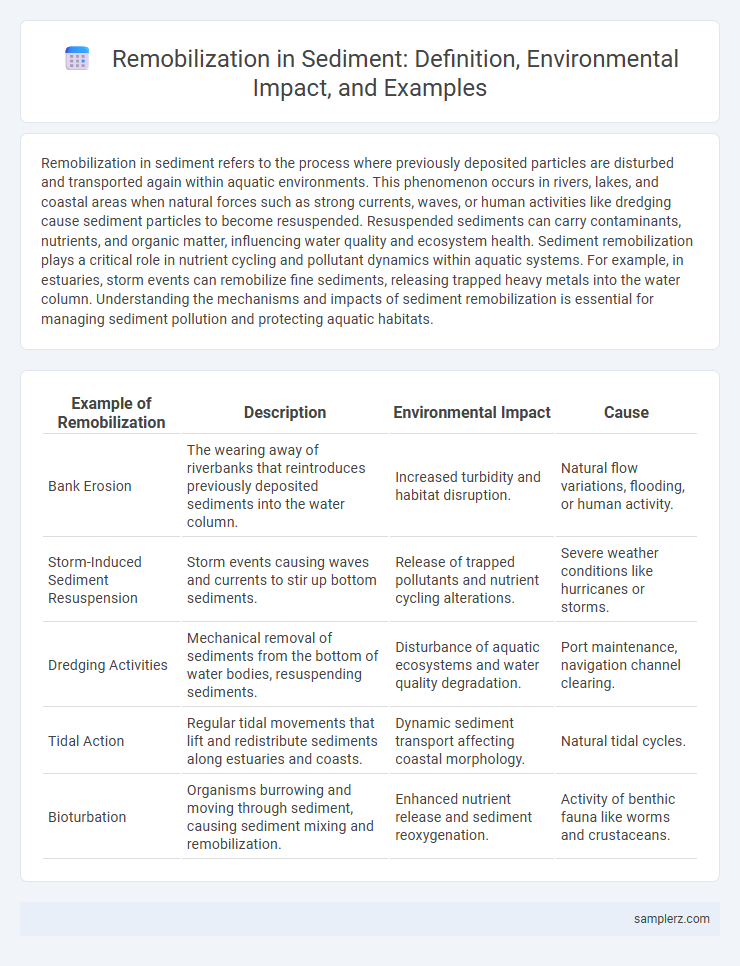Remobilization in sediment refers to the process where previously deposited particles are disturbed and transported again within aquatic environments. This phenomenon occurs in rivers, lakes, and coastal areas when natural forces such as strong currents, waves, or human activities like dredging cause sediment particles to become resuspended. Resuspended sediments can carry contaminants, nutrients, and organic matter, influencing water quality and ecosystem health. Sediment remobilization plays a critical role in nutrient cycling and pollutant dynamics within aquatic systems. For example, in estuaries, storm events can remobilize fine sediments, releasing trapped heavy metals into the water column. Understanding the mechanisms and impacts of sediment remobilization is essential for managing sediment pollution and protecting aquatic habitats.
Table of Comparison
| Example of Remobilization | Description | Environmental Impact | Cause |
|---|---|---|---|
| Bank Erosion | The wearing away of riverbanks that reintroduces previously deposited sediments into the water column. | Increased turbidity and habitat disruption. | Natural flow variations, flooding, or human activity. |
| Storm-Induced Sediment Resuspension | Storm events causing waves and currents to stir up bottom sediments. | Release of trapped pollutants and nutrient cycling alterations. | Severe weather conditions like hurricanes or storms. |
| Dredging Activities | Mechanical removal of sediments from the bottom of water bodies, resuspending sediments. | Disturbance of aquatic ecosystems and water quality degradation. | Port maintenance, navigation channel clearing. |
| Tidal Action | Regular tidal movements that lift and redistribute sediments along estuaries and coasts. | Dynamic sediment transport affecting coastal morphology. | Natural tidal cycles. |
| Bioturbation | Organisms burrowing and moving through sediment, causing sediment mixing and remobilization. | Enhanced nutrient release and sediment reoxygenation. | Activity of benthic fauna like worms and crustaceans. |
Understanding Sediment Remobilization: An Overview
Sediment remobilization refers to the process where previously settled particles are re-entrained into the water column due to physical forces such as currents, waves, or human activities. A common example is the disturbance caused by dredging operations, which resuspend contaminants trapped in sediment, impacting aquatic ecosystems. Understanding the dynamics of sediment remobilization is crucial for predicting pollutant transport and mitigating environmental damage in coastal and riverine environments.
Natural Processes Driving Sediment Remobilization
Natural processes driving sediment remobilization include river floods, tidal actions, and storm events that increase water velocity and turbulence, causing sediments to be resuspended and transported. Coastal erosion and bioturbation by benthic organisms also contribute by disrupting and displacing sediment layers. These dynamic forces reshape aquatic habitats and influence nutrient cycling within sedimentary environments.
Human Activities Contributing to Sediment Remobilization
Human activities such as dredging, deforestation, and construction significantly contribute to sediment remobilization by disturbing soil and underwater sediments. Agricultural practices, including intensive tillage and irrigation, increase sediment displacement into water bodies, affecting aquatic ecosystems. Urban development alters natural land surfaces, accelerating erosion and the redistribution of sediment in rivers and coastal areas.
Coastal Erosion as a Case of Sediment Remobilization
Coastal erosion exemplifies sediment remobilization by redistributing shoreline sediments through wave action and tidal currents, causing significant habitat alteration and land loss. The continuous removal and transport of sand and silt along coastlines impact sediment budgets and influence sedimentary processes in estuarine and marine environments. Monitoring these dynamics is critical for managing coastal resilience and mitigating erosional hazards exacerbated by sea-level rise and human activity.
River Flood Events and Sediment Transport
River flood events significantly influence sediment transport by remobilizing deposited materials from riverbeds and banks, increasing sediment load downstream. During floods, high flow velocities and turbulent water flow resuspend fine sediments and organic matter, altering nutrient dynamics and contaminant distribution. This remobilization process plays a crucial role in shaping river morphology and maintaining ecosystem health.
Reservoirs and Dams: Triggers for Sediment Remobilization
Sediment remobilization in reservoirs and dams occurs when fluctuations in water levels, such as during reservoir drawdown or dam releases, disturb previously settled sediments. This process can resuspend contaminants and nutrients trapped in the sediment, impacting downstream water quality and aquatic ecosystems. Hydraulic changes and turbulence generated by dam operations are key triggers that exacerbate sediment transport and redistribution in these engineered water bodies.
Sea Level Rise and Sediment Redistribution
Sea level rise drives sediment remobilization by increasing coastal erosion and inundation, which redistributes sediment from beaches and estuaries into offshore and deeper marine environments. This process alters sediment transport patterns, leading to loss of coastal habitats and changes in sediment deposition rates. The enhanced sediment flux impacts nutrient cycles and carbon storage in marine ecosystems, influencing overall environmental health.
Impact of Storm Surges on Sediment Remobilization
Storm surges significantly impact sediment remobilization by rapidly altering coastal hydrodynamics and eroding seabed deposits, leading to the redistribution of sediments along shorelines. These events increase turbidity, disrupt benthic habitats, and facilitate the transport of contaminated sediments, exacerbating ecological risks. Understanding sediment dynamics during storm surges is crucial for effective coastal management and mitigating erosion and habitat loss.
Environmental Consequences of Sediment Remobilization
Sediment remobilization can release toxic contaminants such as heavy metals and organic pollutants trapped in the sediment layers, posing risks to aquatic ecosystems and human health. This process often increases water turbidity, reducing light penetration and disrupting photosynthesis in aquatic plants. Remobilized sediments also contribute to habitat degradation and can alter nutrient cycles, leading to issues like algal blooms and oxygen depletion.
Monitoring and Managing Sediment Remobilization Events
Monitoring sediment remobilization events involves continuous sampling and real-time sensor deployment to detect shifts in sediment composition and contaminant levels. Managing these events requires adaptive strategies such as sediment trapping, controlled dredging, and habitat restoration to minimize ecological disruption and pollutant spread. Data-driven models enhance prediction accuracy, improving response times and reducing impacts on aquatic ecosystems.

example of remobilization in sediment Infographic
 samplerz.com
samplerz.com